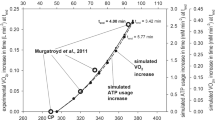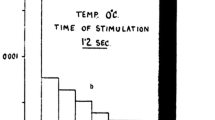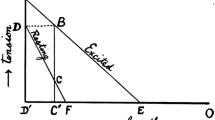Abstract
Like any other kind of cell, muscle cells produce energy by oxidizing the fuel substrate that they absorb together with the needed oxygen from the surroundings. Oxidation occurs entirely within the cell. It means that the reactants and products of reaction must at some time be dissolved in the cell’s cytosol. If a cell operates at steady state, its cytosol composition remains constant. Therefore, the cytosol in a muscle that produces work at steady state must contain a constant amount of fuel, oxygen, and product of reaction dissolved in it. The greater the power produced, the higher the concentration of these solutes. There is a limit, however, to the maximum amount of solutes that the cytosol can contain without damaging the cell. General thermodynamic arguments, which are reviewed in this paper, help relate this limit to the dehydration and overhydration limits of the cell. The present analysis shows that the same limits entail a limit to the maximum power that a muscle can produce at steady state. This limit depends on the composition of the fuel mixture used by the muscle. The analysis also determines the number of fuel carbon atoms that must be oxidized in parallel within a cell to produce a given power. It may well happen that a muscle cannot reach the maximum attainable power because it cannot activate all the parallel oxidation paths that are needed to produce it. This may be due to a series of reasons ranging from health issues to a lack of training. The paper shows how the methods of indirect calorimetry can provide all the experimental data needed to determine the actual number of parallel oxidation paths that at steady state must be active in a muscle in a given exercise. A diagram relating muscle power to the number of parallel oxidation paths and fuel composition is finally presented. It provides a means to assess the power capacity of animal muscles and can be applied to evaluate their fitness, stamina, margins for improvement, and athletic potential.




Similar content being viewed by others
References
Paglietti, A.: Thermodynamic Limit to the Existence of Inanimate and Living Systems. Sepco-Acerten, Milan (2014)
Paglietti, A.: Limits to anaerobic energy and cytosolic concentration in the living cell. Phys. Rev. E 92, 052512.1–052712.9 (2015)
Smith, N.P., Barclay, C.J., Loiselle, D.S.: The efficiency of muscle contraction. Prog. Biophys. Mol. Biol. 88, 1–58 (2005)
Barclay, C.J.: The basis of differences in thermodynamic efficiency among skeletal muscles. Clin. Exp. Pharmacol. Physiol. 44, 1279–1286 (2017)
Lichtwark, G.A., Barclay, C.J.: The influence of tendon compliance on muscle power output and efficiency during cyclic contractions. J. Exp. Biol. 213, 707–714 (2010)
Jubrias, S.A., Vollestad, N.K., Gronka, R.K., Kushmerick, M.J.: Contraction coupling efficiency of human first dorsal interosseous muscle. J. Physiol. 586, 1993–2002 (2008)
Nelson, F.E., Ortega, J.D., Jubrias, S.A., Conley, K.E., Kushmerick, M.J.: High efficiency in human muscle: an anomaly and an opportunity? J. Exp. Biol. 214, 2649–2653 (2011)
He, Z.-H., Bottinelli, R., Pellegrino, M.A., Ferenczi, M.A., Reggiani, C.: ATP consumption and efficiency of human single muscle fibers with different myosin isoform composition. Biophys. J. 79, 945–961 (2000)
Morris, C.R., Nelson, F.E., Askew, G.N.: The metabolic power requirements of flight and estimations of flight muscle efficiency in the cockatiel (Nymphicus hollandicus). J. Exp. Biol. 213(16), 2788–2796 (2010)
Coyle, E.F., Sidossis, L.S., Horowitz, J.F., Beltz, J.D.: Cycling efficiency is related to percentage of type I muscle fibers. Med. Sci. Sports Exerc. 24(7), 782–788 (1992)
Powers, S.K., Beadle, R.E., Mangum, M.: Exercise efficiency during arm ergometry: effects of speed and work rate. J. Appl. Physiol. 56, 495–499 (1984)
Holt, N.C., Askew, G.N.: The effects of asymmetric length trajectories on the initial mechanical efficiency of mouse soleus muscles. J. Exp. Biol. 215, 324–330 (2012)
Barclay, C.J.: Energetics of contraction. Compr. Physiol. 5, 961–995 (2015)
Atkins, P., De Paula, J.: Physical Chemistry, 10th edn. Oxford University Press, Oxford (2014)
Silbey, R.J., Alberty, R.A., Bawendi, M.G.: Physical Chemistry, 4th edn. Wiley, Hoboken (2005)
Nelson, D.L., Kox, M.M.: Lehninger Principles of Biochemistry, 6th edn. Freeman, New York (2013)
Venables, M.C., Achten, J., Jeukendrup, A.E.: Determinants of fat oxidation during exercise in healthy men and women: a cross-sectional study. J. Appl. Physiol. 98, 160–167 (2005)
Kuzmiak-Glancy, S., Willis, W.T.: Skeletal muscle fuel selection occurs at the mitochondrial level. J. Exp. Biol. 217, 1993–2003 (2014)
Frayn, K.N.: Calculation of substrate oxidation rates in vivo from gaseous exchange. J. Appl. Physiol. 55, 628–634 (1983)
Kiens, B., Éssen-Gustavsson, B., Christensen, N.J., Saltin, B.: Skeletal muscle substrate utilization during submaximal exercise in man: effect of endurance training. J. Physiol. 469, 459–478 (1993)
Romijn, J.A., Coyle, E.F., Sidossis, L.S., Gastaldelli, A., Horowitz, J.F., Endert, E., Wolfe, R.R.: Regulation of endogenous fat and carbohydrate metabolism in relation to exercise intensity and duration. Am. J. Phys. 265, E380–E391 (1993)
Kelley, D.E., Mokan, M., Simoneau, J.-A.: Interaction between glucose and free fatty acid metabolism in human skeletal muscle. J.Clin. Invest. 92, 91–98 (1993)
Van Hall, G., Sacchetti, M., Rådegran, G., Saltin, B.: Human skeletal muscle fatty acid and glycerol metabolism during rest, exercise and recovery. J. Physiol. 543(3), 1047–1058 (2002)
Van den Borne, J.J.G.C., Heetkamp, M.J.W., Alferink, A.J.J., Gerrits, W.J.J.: Moving from a complete energy balance towards substrate oxidation: use of stable isotopes. In: Gerrit, W.J.J., Labussière, E. (eds.) Indirect Calorimetry, Ch. 5, pp. 87–113. Wageningen Ac. Publ, The Netherlands (2015)
Turcoatte, L.P., Hespel, P.J., Graham, T.E., Richter, E.A.: Impaired plasma FFA oxidation imposed by extreme CHO deficiency in contracting rat skeletal muscle. J. Appl. Physiol. 77, 517–525 (1994)
Masoro, E.J., Felts, J.M.: Role of carbohydrate metabolism in promoting fatty acid oxidation. J. Biol. Chem. 231, 347–356 (1958)
McArdle, W.D., Katch, F.I., Katch, V.L.: Exercise Physiology: Nutrition, Energy and Human Performance, 7th edn. Lippincott Williams & Wilkins, Baltimore (2010)
Strange, K.: Cellular volume homeostasis. Adv. Physiol. Educ. 28, 155–159 (2004)
Alberts, B., Bray, D., Hopkin, K., Johnson, A.D., Lewis, J., Raff, M., Roberts, K., Walter, P.: Essential Cell Biology, 4th edn. Garland Science, New York (2014)
Rich, P.R.: The molecular machinery of Keilin’s respiratory chain. Biochem. Soc. Trans. 31, 1095–1105 (2003)
Smith, J.C., Hill, D.W.: Contribution of energy systems during a Wingate power test. Br. J. Sports Med. 25, 196–199 (1991)
Berg, J.M., Tymoczko, J.L., Gatto, G.J., Stryer, L.: Biochemistry, 8th edn. Freeman, New York (2015)
Bloomstrand, E., Rådegran, G., Saltin, B.: Maximum rate of oxygen uptake by human skeletal muscle in relation to enzymes activities of enzymes in Krebs cycle. J. Physiol. 501, 455–460 (1997)
Gifford, J.R., Garten, R.S., Nelson, A.D., Trinity, J.D., Layec, G., Witman, M.A.H., Weavil, J.C., Mangum, T., Hart, C., Etheredge, C., Jessop, J., Bledsoe, A., Morgan, D.E., Wray, D.W., Rossman, M.J., Richardson, R.S.: Symmorphosis and skeletal muscle \( {\overset{.}{V}}_{O_2\max } \): in vivo and in vitro measures reveal differing constraints in the exercise-trained and untrained human. J. Physiol. 594, 1741–1751 (2016)
Rasmussen, U.F., Rasmussen, H.N., Krustrup, P., Quistorff, B., Saltin, B., Bangsbo, J.: Aerobic metabolism of human quadriceps muscle: in vivo data parallel measurements on isolated mitochondria. Am. J. Physiol. Endocrinol. Metab. 280, E301–E307 (2001)
Graham, J.A., Scobie, G.W.: Muscle biopsy measurement of body water and intracellular electrolytes in children. Arch. Dis. Child. 45, 473–477 (1970)
Antolic, A., Harrison, R., Farlinger, C., Cermak, N.M., Peters, S.J., LeBlanc, P., Roy, B.D.: Effect of extracellular osmolality on cell volume and resting metabolism in mammalian skeletal muscle. Am. J. Plysiol. Regul. Integr. Comp. Physiol. 292, R1994–R2000 (2007)
Lindinger, M.I., Leung, M., Trajcevski, K.E., Hawke, T.J.: Volume regulation in mammalian skeletal muscle: the role of sodium-potassium-chloride cotransporters during exposure to hypertonic solutions. J. Physiol. 589, 2887–2899 (2011)
Tavichakorntrakool, R., Prasongwattana, V., Sriboonlue, P., Puapairoj, A., Wongkham, C., Wiangsimma, T., Khunkitti, W., Triamjangarun, S., Tanratanauijit, M., Chamsuwan, A., Khunkitti, W., Yenchitsomanus, P.-T., Thongboonkerd, V.: K+, Na+, Mg2 +, Ca2 +, and water contents in human skeletal muscle: correlations among these monovalent and divalent cations and their alterations in K+-depleted subjects. Transl. Res. 150, 357–366 (2007)
Cieslar, J., Huang, M.-T., Dobson, G.P.: Tissue spaces in rat heart, liver and skeletal muscle in vivo. Am. J. Phys. 275, R1530–R1536 (1998)
Lindinger, M.I., Heigenhauser, G.J.F.: The roles of ion fluxes in skeletal muscle fatigue. Can. J. Physiol. Pharmacol. 69, 246–253 (1991)
Lindinger, M.I., Spriet, L.L., Hultman, E., Putman, T., McKelvie, R.S., Lands, L.C., Jones, N.L., Heigenhauser, G.J.F.: Plasma volume and ion regulation during exercise after low- and high-carbohydrate diets. Am. J. Physiol. Regul. Integr. Comp. Physiol. 266, R1896–R1906 (1994)
Raja, M.K., Raymer, G.H., Moran, G.R., Marsh, G., Thompson, R.T.: Changes in tissue water content measured with multiple-frequency bioimpedance and metabolism measured with 31P-MRS during progressive forearm exercise. J. Appl. Physiol. 101, 1070–1075 (2006)
Walsh, R.M., Noakes, T.D., Hawley, J.A., Dennis, S.C.: Impaired high-intensity cycling performance time at low levels of dehydration. Int. J. Sports Med. 15, 392–398 (1994)
Sawka, M.N., Cheuvront, S.N., Kenefick, R.W.: Hypohydration and human performance: impact of environment and physiological mechanisms. Sports Med. 45(Suppl 1), S51–S60 (2015)
Hughes, S.M., Schiaffino, S.: Control of muscle fibre size: a crucial factor in ageing. Acta Physiol. Scand. 167, 307–312 (1999)
Bergman, B.C., Brooks, G.A.: Respiratory gas-exchange ratios during graded exercise in fed and fasted trained and untrained men. J. Appl. Physiol. 86, 479–487 (1999)
Peric, R., Meucci, M., Nikolowski, Z.: Fat utilization during high-intensity exercise: when does it ends? Sports Med. Open 2(1), 35–41 (2016)
Ettema, G., Lorås, H.W.: Efficiency in cycling: a review. Eur. J. Appl. Physiol. 106, 1–14 (2009)
Askew, G.N., Ellerby, D.J.: The mechanical power requirement of avian flight. Biol. Lett. 3, 445–448 (2007)
Ellerby, B.J., Askew, G.N.: Modulation of flight muscle power output in budgerigars Melopsittacus undulates and zebra finches Taeniopygia guttata: in vitro muscle performance. J. Exp. Biol. 210, 3780–3788 (2007)
Warrick, D., Hedrick, T., Fernandez, M.J., Tobalske, B., Biewener, A.A.: Hummingbird flight. Curr. Biol. 22, R472–R477 (2012)
Acknowledgements
I wish to thank the Editor, Dr. Sonya Bahar, for her liberal attitude when handling the reviewing procedure of this paper, and the two unknown reviewers who took their time to read the original manuscript. Their constructive comments were most gratifying to me and enabled me to improve the paper in several important points.
Author information
Authors and Affiliations
Corresponding author
Ethics declarations
Conflict of interest
The author declares that he has no conflict of interest.
Rights and permissions
About this article
Cite this article
Paglietti, A. Limit to steady-state aerobic power of skeletal muscles. J Biol Phys 44, 619–646 (2018). https://doi.org/10.1007/s10867-018-9510-y
Received:
Accepted:
Published:
Issue Date:
DOI: https://doi.org/10.1007/s10867-018-9510-y




